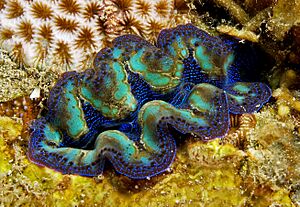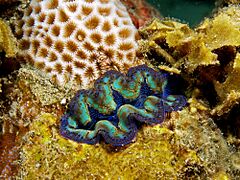Boring clam facts for kids
Quick facts for kids Boring clam |
|
|---|---|
 |
|
| Boring clam with mantle extended | |
| Conservation status | |
|
Least Concern
|
|
|
Protected (CITES Appendix II)
|
|
| Scientific classification |
The boring clam (scientific name: Tridacna crocea) is a type of bivalve. Bivalves are molluscs with two shells, like oysters or mussels. This clam is also known as the crocus clam or saffron-coloured clam. It lives in the Indo-Pacific region and is sometimes kept in home aquariums.
What Does the Boring Clam Look Like?
The boring clam is the smallest type of giant clam. Its shell can grow up to 15 centimeters (about 6 inches) long. It has two thick shells, called valves, connected by a hinge. This hinge is usually about one-third to less than half the width of the shell. The shells are often a bit long and puffy, especially near the hinge.
The top shell has 6 to 10 flat folds. These folds fit together with similar folds on the bottom shell. This allows the clam to close its shell very tightly. The bottom shell has small openings. Through these openings, the clam sends out strong threads called byssal threads. These threads help the clam attach itself firmly to the seabed.
This clam digs into rocks or coral. This digging process often makes the outside of its shells smooth. Sometimes, the shells might look a bit uneven if the clam digs into areas with different hardness.
The shells are usually grayish-white. They might have a hint of pink-orange, yellow, or orange color. This color can form a band near the top edge, especially inside the shell. When the clam opens its shells, its soft body wall, called the mantle, sticks out. The mantle is very colorful. It can be blue, green, purple, gold, orange, or brown. It often has patterns like spots, stripes, or squiggles. The mantle also has many small bumps and a line of simple eyes near its edge.
The clam takes in water through a tube called the inhalent siphon. This siphon is surrounded by many small, finger-like parts called tentacles. The clam sends water out through another tube, the exhalent siphon, which is often long and thin.
Where Do Boring Clams Live?
The boring clam is found in the Indo-Pacific region. Its home range stretches from Malaysia, Vietnam, and Japan down to Indonesia, the Philippines, Palau, New Guinea, Australia, the Solomon Islands, and Vanuatu. It used to live in Guam and the Northern Mariana Islands. However, it might have disappeared from those places, meaning it is now locally extinct there. Boring clams typically live embedded in large corals.



